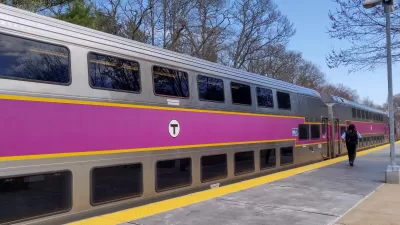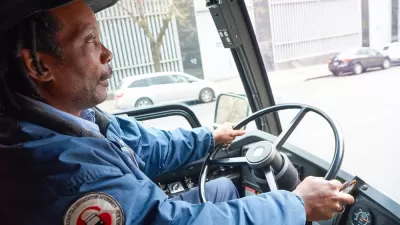The bus lanes have improved travel times, but who should cover the costs isn't entirely clear.

Adam Vaccaro reports that a bus-only lane started last year is significantly speeding up buses traveling on Washington Street. Both the city and the Massachusetts Bay Transportation Authority agree that the lane is a success and an improvement that can be widely used in the region.
"But it has also raised a tough question: Who is responsible for managing these additions to the roads — the state-run transit agency that owns the buses or the city that owns the streets?" says Vaccaro.
The city is suggesting that the MBTA should help support the next phase of the project by covering expenses such as signage and paint for the lanes. While costs normally are the responsibility of a city or town, Boston pays more to the MBTA through assessments than any other municipality.
"Activists see this as the kind of typical Boston-area jurisdictional dispute that threatens to slow adoption of a transportation improvement at a critical time," reports Vaccaro. Still, bus lanes are faring well, and both state and local officials are heralding them as a cost-effective solution for tackling regional traffic problems.
While the issue of financial contributions remains up in the air, more lanes are are on the horizon, reports Vaccaro:
The [Marty] Walsh administration plans to hire the city’s first-ever transit director to work directly with the T on planning and implementing bus lanes, as well as other staffers to monitor them on a daily basis. City officials said that they expect to discuss the issue with new MBTA general manager Steve Poftak — whose appointment was praised by Walsh — who started the job this week.
MBTA officials say they are working with the city to resolve the issue, and advocates say they would like to see a signed agreement between the agency and the city.
FULL STORY: Boston’s new bus-only lanes are an improvement. But who will pay for them?

Planetizen Federal Action Tracker
A weekly monitor of how Trump’s orders and actions are impacting planners and planning in America.

San Francisco's School District Spent $105M To Build Affordable Housing for Teachers — And That's Just the Beginning
SFUSD joins a growing list of school districts using their land holdings to address housing affordability challenges faced by their own employees.

The Tiny, Adorable $7,000 Car Turning Japan Onto EVs
The single seat Mibot charges from a regular plug as quickly as an iPad, and is about half the price of an average EV.

With Protected Lanes, 460% More People Commute by Bike
For those needing more ammo, more data proving what we already knew is here.

In More Metros Than You’d Think, Suburbs are Now More Expensive Than the City
If you're moving to the burbs to save on square footage, data shows you should think again.

The States Losing Rural Delivery Rooms at an Alarming Pace
In some states, as few as 9% of rural hospitals still deliver babies. As a result, rising pre-term births, no adequate pre-term care and "harrowing" close calls are a growing reality.
Urban Design for Planners 1: Software Tools
This six-course series explores essential urban design concepts using open source software and equips planners with the tools they need to participate fully in the urban design process.
Planning for Universal Design
Learn the tools for implementing Universal Design in planning regulations.
Smith Gee Studio
City of Charlotte
City of Camden Redevelopment Agency
City of Astoria
Transportation Research & Education Center (TREC) at Portland State University
US High Speed Rail Association
City of Camden Redevelopment Agency
Municipality of Princeton (NJ)





























